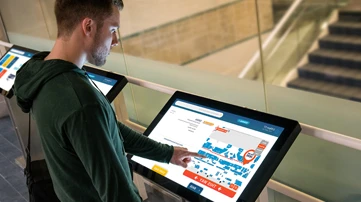In today’s fast-paced world, restaurants are constantly seeking innovative ways to enhance their profitability and streamline operations. One such innovation that has revolutionized the dining experience is digital menu boards. These dynamic displays not only captivate customers but also serve as powerful tools for maximizing sales and increasing revenue for restaurants.
Gone are the days of static, printed menu boards that remain unchanged for extended periods. Digital menu boards offer restaurants the flexibility to update menu items, pricing, and promotions in real-time, ensuring that customers are always presented with the most current offerings. This agility enables restaurants to capitalize on market trends, seasonal ingredients, and changing consumer preferences, thereby optimizing sales opportunities.
One of the key advantages of digital menu boards is their ability to showcase visually appealing content that grabs the attention of customers. With vibrant images, enticing videos, and interactive features, these digital displays create a captivating dining environment that stimulates appetite and encourages impulse purchases. By strategically highlighting high-margin items, chef specials, and promotional combos, restaurants can influence customer choices and drive sales of targeted menu items.
Moreover, digital menu boards empower restaurants to implement dynamic pricing strategies based on various factors such as time of day, day of the week, and customer demographics. For instance, restaurants can offer discounted lunch specials during off-peak hours to attract more patrons or adjust pricing during happy hours to boost beverage sales. This flexibility enables restaurants to optimize pricing strategies in real-time, maximizing revenue potential and profitability.
Another significant benefit of digital menu boards is their role in enhancing the overall customer experience. By providing engaging content, relevant information, and seamless navigation, these displays streamline the ordering process and reduce wait times, resulting in higher customer satisfaction levels. Additionally, digital menu boards can incorporate interactive features such as nutritional information, allergen alerts, and customization options, catering to diverse dietary preferences and enhancing transparency.
Furthermore, digital menu boards facilitate upselling and cross-selling opportunities by strategically promoting complementary products and add-ons. Through suggestive selling techniques and eye-catching visuals, restaurants can encourage customers to upgrade their orders, add side dishes, or try new menu items, thereby increasing the average check size and driving incremental revenue. By leveraging data analytics and customer feedback, restaurants can refine their upselling strategies and tailor promotions to maximize effectiveness.
In addition to boosting sales and profitability, digital menu boards offer operational efficiencies that contribute to cost savings and improved workflow management. Unlike traditional menu boards that require manual updates and printing costs, digital displays can be easily managed and updated remotely via cloud-based software. This centralized control allows restaurants to streamline menu changes, eliminate printing expenses, and reduce waste associated with outdated materials.
Moreover, digital menu boards facilitate inventory management and supply chain optimization by providing real-time visibility into menu performance and product demand. By tracking sales trends, inventory levels, and ingredient usage, restaurants can make data-driven decisions to minimize waste, optimize inventory levels, and prevent stockouts. This proactive approach to inventory management not only reduces costs but also ensures consistency in menu offerings and enhances operational efficiency.
In conclusion, digital menu boards for restaurants represent a powerful tool for maximizing sales and improving profitability in the restaurant industry. By leveraging dynamic content, flexible pricing strategies, and interactive features, restaurants can create engaging dining experiences that drive customer engagement, increase sales, and boost revenue. Moreover, digital menu boards offer operational efficiencies that streamline workflow management, reduce costs, and optimize inventory control. As restaurants continue to adapt to evolving consumer preferences and market dynamics, digital menu boards will remain essential assets for enhancing profitability and staying competitive in the modern dining landscape.





